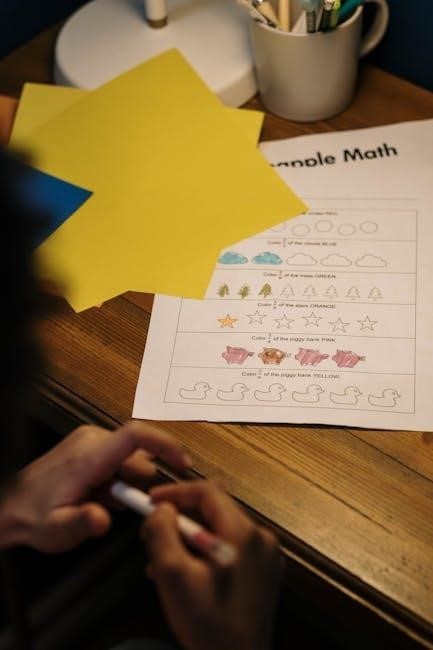Decimal operations worksheets, specifically Grade 6 focused materials for Florida standards, provide essential practice. These PDF resources, from sources like 3P Learning, cover addition, subtraction, multiplication, and division with decimals.
These worksheets aid in mastering arithmetic with decimal numbers, building a strong foundation for more advanced mathematical concepts, and are often available as Google Forms quizzes.
What are Decimal Operations?
Decimal operations encompass the fundamental arithmetic processes – addition, subtraction, multiplication, and division – applied to numbers containing a decimal point. These operations build upon whole number arithmetic, extending mathematical capabilities to represent and manipulate quantities more precisely.
Understanding decimal place value is crucial; each position to the right of the decimal represents a power of ten (tenths, hundredths, thousandths, etc.). Worksheets focusing on these operations, often in PDF format for Grade 6 students, emphasize aligning decimal points correctly during addition and subtraction.
Multiplication involves treating the decimal initially as if it weren’t there, then placing the decimal in the product based on the total number of decimal places in the factors. Division requires careful consideration of remainders and potentially estimating the quotient. Mastering these skills is foundational for real-world applications.
Why Use Worksheets for Decimal Practice?
Decimal operations worksheets, frequently available as PDF downloads, provide targeted practice essential for solidifying understanding. They offer a structured approach to mastering skills like aligning decimal points, performing calculations, and interpreting results – crucial for Grade 6 students and beyond.
Worksheets allow students to work independently, reinforcing concepts at their own pace. The repetitive nature of problems builds fluency and confidence. Furthermore, PDF formats are easily printable for offline practice or can be utilized in digital formats like Google Forms quizzes for immediate feedback.
These resources, such as those aligned with Florida standards, move beyond rote memorization, encouraging problem-solving and application of decimal concepts to real-world scenarios. Consistent practice with worksheets is key to developing proficiency.

Addition of Decimals
Decimal addition requires aligning place values and carefully summing the numbers, as demonstrated in PDF worksheets. Rewiring numbers ensures correct alignment for accurate practice.
Understanding Decimal Place Value
Decimal place value is foundational to accurately performing operations. Worksheets emphasize recognizing the value of each digit to the right of the decimal point – tenths, hundredths, thousandths, and so on. A solid grasp of this concept, reinforced through PDF practice materials, is crucial for success.
Understanding that 82.356 has 3 in the tenths place, 5 in the hundredths, and 6 in the thousandths is key. These operations with decimals worksheets often include exercises specifically designed to assess and build this understanding. Correctly identifying place value prevents errors during addition, subtraction, multiplication, and division.
Furthermore, aligning decimals correctly during calculations directly relies on recognizing equivalent place values. The digit’s position determines its contribution to the overall value, and mastering this is essential for confident problem-solving, as highlighted in available resources.
Adding Decimals with the Same Number of Decimal Places
When adding decimals possessing the same number of decimal places, the process mirrors whole number addition, but with crucial alignment. PDF worksheets frequently begin with these straightforward problems to build confidence. Students are instructed to “rewire” both numbers and meticulously line up the decimal points vertically.
For example, adding 24.31 and 52.83 involves aligning the ones, tenths, and hundredths columns. The sum is then calculated column by column, carrying over as needed. This method, emphasized in practice materials, minimizes errors and reinforces the importance of place value.
These initial exercises, often presented without calculator use, establish a strong procedural understanding. Mastering this foundational skill prepares students for more complex decimal addition scenarios involving differing decimal places.
Adding Decimals with Different Numbers of Decimal Places
PDF worksheets progressively introduce the challenge of adding decimals with varying decimal places. A key step involves ensuring proper alignment; students must mentally or physically add trailing zeros to the shorter decimal to equalize the place values. This maintains the number’s value while facilitating accurate column addition.
For instance, adding 340.8 and 24.7 requires rewriting 340.8 as 340.80. This ensures the tenths and hundredths columns align correctly. The addition then proceeds as before, column by column, with carrying over as necessary.
Practice materials emphasize this technique, often including numerous examples to solidify understanding. These exercises build upon the foundation of adding decimals with identical place values, preparing students for real-world applications.
Real-World Applications of Decimal Addition
PDF worksheets frequently incorporate word problems demonstrating the practical relevance of decimal addition. These scenarios mirror everyday situations, enhancing student engagement and comprehension. For example, a problem might ask students to calculate Regan’s weekly earnings, given an hourly rate of $6.70 and 8 hours worked – requiring addition of a decimal multiplied by a whole number.
Other applications include calculating total costs with tax, combining measurements (like lengths or weights), and determining change received after a purchase. These problems reinforce the idea that decimals aren’t abstract concepts, but tools for solving practical challenges.
Worksheets often present these applications in relatable contexts, fostering a deeper understanding of how decimal addition is used outside the classroom.

Subtraction of Decimals
Decimal subtraction worksheets, often in PDF format, emphasize aligning place values. Mastering this skill, alongside borrowing techniques, is crucial for accurate calculations.
Subtracting Decimals with Aligned Place Values
Decimal subtraction worksheets heavily emphasize the fundamental importance of correctly aligning place values before commencing calculations. This foundational step ensures accuracy and prevents common errors. Students practicing with PDF resources will encounter numerous problems designed to reinforce this concept.
The core principle involves lining up the decimal points vertically, ensuring that tenths are under tenths, hundredths under hundredths, and so on. This alignment directly reflects the value of each digit. Worksheets often include examples and guided practice to solidify understanding.
For instance, when subtracting 52.83 from 24.31, the numbers are written as:
24.31
– 52.83
Proper alignment is the first, and arguably most critical, step in successful decimal subtraction. Without it, the resulting answer will inevitably be incorrect.
Borrowing with Decimals
Decimal subtraction worksheets frequently incorporate problems requiring borrowing, mirroring the process used with whole numbers, but with added nuance. When a digit in the minuend is smaller than the corresponding digit in the subtrahend, borrowing becomes necessary. This involves taking one from the next higher place value to the left.
For example, consider subtracting 3.25 from 5.12. When subtracting 5 from 2 in the hundredths place, borrowing is required. One tenth is borrowed from the 1 in the tenths place, becoming 0, and the 2 in the hundredths place becomes 12.
PDF practice materials provide ample opportunities to master this skill. Worksheets often start with simpler examples and gradually increase in complexity. Understanding borrowing with decimals is crucial for accurate calculations and builds confidence in decimal arithmetic.
Decimal Subtraction Problem Solving
Decimal subtraction worksheets aren’t just about calculations; they emphasize applying subtraction to real-world scenarios. PDF resources often present word problems requiring students to identify the necessary operation – subtraction – and correctly set up the problem with aligned decimal points.
These problems might involve calculating change received after a purchase, determining the difference between two measurements, or finding how much further one distance is than another. Successfully solving these requires careful reading and understanding of the context.
Practice includes scenarios like Regan earning a wage and needing to calculate total earnings after a set number of hours. Mastering these skills, through consistent practice on operations with decimals, builds problem-solving abilities and reinforces mathematical fluency.

Multiplication of Decimals
Decimal multiplication, found in PDF worksheets, mirrors whole number multiplication, but requires careful decimal point placement in the final product for accuracy.
Multiplying Decimals by Whole Numbers
Worksheets focusing on multiplying decimals by whole numbers present a foundational step in mastering decimal operations. The process itself is straightforward: treat the decimal as if it were a whole number and perform the multiplication as usual. The key lies in correctly positioning the decimal point within the product.
Typically, students are guided to count the total number of decimal places in the original decimal factor. This count then dictates how many places to move the decimal point to the left in the final answer. For example, multiplying 3.2 by 5 involves treating it as 32 multiplied by 5, resulting in 160, then shifting the decimal one place to the left, yielding 16.0 or simply 16.
PDF resources often include numerous practice problems, gradually increasing in complexity, to reinforce this skill; These exercises help students build confidence and accuracy in decimal multiplication, preparing them for more challenging scenarios involving decimals multiplied by other decimals.
Multiplying Decimals by Decimals
Worksheets dedicated to multiplying decimals by decimals build upon the previous skill of multiplying by whole numbers, introducing a slightly more complex process. Students learn to treat the decimals initially as whole numbers, performing standard multiplication without considering the decimal points.
The crucial step involves determining the total number of decimal places in both factors combined. This combined count dictates the placement of the decimal point in the final product. For instance, multiplying 2.3 by 1.4 involves ignoring the points initially, resulting in 322. Since 2.3 has one decimal place and 1.4 has one, the product requires two decimal places, giving 3.22.
PDF practice materials often emphasize careful counting and accurate placement. These resources, frequently found as part of broader decimal operations packets, provide ample opportunity to solidify this skill, preparing students for estimation and real-world applications.
Estimating Decimal Products
Worksheets focusing on estimating decimal products are vital for developing number sense and providing a quick check for the reasonableness of calculated answers. This skill involves rounding each factor in the multiplication problem to the nearest whole number or a simpler decimal before performing the calculation.
For example, to estimate 4.8 x 2.1, students might round 4.8 to 5 and 2.1 to 2, resulting in an estimated product of 10. This allows for a rapid assessment of whether a precisely calculated answer (which would be 10.08) is within a reasonable range.
PDF resources often include exercises specifically designed to practice rounding and then estimating. These decimal operations worksheets, commonly found for Grade 6, emphasize mental math strategies and build confidence in approaching more complex multiplication problems.

Division of Decimals
Decimal division worksheets, often in PDF format, cover dividing by whole numbers and decimals, addressing remainders and real-world problem-solving scenarios.
Dividing Decimals by Whole Numbers
Dividing decimals by whole numbers is a foundational skill reinforced through dedicated worksheet practice. These PDF resources typically present problems where a decimal number is divided by a whole number, requiring students to understand the placement of the decimal point in the quotient.
The process mirrors long division with whole numbers, but necessitates careful attention to bringing down the decimal point directly above its corresponding position in the dividend. Worksheets often include examples demonstrating this process step-by-step, building confidence and accuracy.
Many operations with decimals worksheets emphasize rewriting the problem to avoid confusion, sometimes adding trailing zeros to the dividend if needed. This ensures a clear understanding of place value during the division process. Digital versions, like Google Forms quizzes, offer immediate feedback, enhancing the learning experience.
Dividing Decimals by Decimals
Dividing decimals by other decimals introduces a layer of complexity addressed through targeted worksheet practice available in PDF format. These resources focus on the crucial step of transforming the divisor into a whole number by multiplying both the divisor and dividend by a power of ten.
This process maintains the ratio between the numbers while simplifying the division process. Worksheets often provide guided examples illustrating this technique, emphasizing the importance of consistently applying the same multiplication factor to both numbers.
Students learn to carefully align decimal points and perform long division as usual, ensuring the decimal point in the quotient is correctly positioned. Digital adaptations, such as Google Forms quizzes, provide instant feedback and reinforce the concept. Mastering this skill is vital for advanced mathematical applications.
Dealing with Remainders in Decimal Division
Decimal division worksheets, often available as PDF downloads, dedicate significant attention to handling remainders. Unlike whole number division, decimal division frequently results in remainders that require continuation beyond the whole number portion.
These worksheets guide students to add zeros to the dividend as placeholders, allowing the division process to continue and generate decimal places in the quotient. This technique ensures accuracy and provides a more precise answer than simply truncating the result.
Practice problems emphasize recognizing when to add these placeholders and correctly positioning the decimal point in the quotient. Digital resources, like Google Forms quizzes, offer immediate feedback on remainder handling. Understanding this concept is crucial for real-world applications and further mathematical study.

Decimal Operations Worksheet Features
PDF worksheets for decimal operations include addition, subtraction, multiplication, and division problems. They cater to Grade 6 students, offering varied difficulty levels for effective practice.
Types of Problems Included (Addition, Subtraction, Multiplication, Division)

Decimal operations worksheets comprehensively cover the four fundamental arithmetic processes. Addition problems range from simple alignment and summing to scenarios requiring regrouping with decimals. Subtraction exercises focus on proper alignment and borrowing techniques when dealing with differing place values.
Multiplication problems include multiplying decimals by whole numbers and other decimals, emphasizing correct decimal placement in the product. Division problems involve dividing decimals by whole numbers and decimals, potentially including scenarios with remainders.
These PDF resources, often available as Google Forms quizzes, provide ample practice. Worksheets frequently incorporate real-world applications, such as calculating costs or measurements, to enhance understanding and relevance. The goal is to build fluency across all decimal operation types.
Worksheet Difficulty Levels (Grade 6 Focus)
Decimal operations worksheets designed for Grade 6 progressively increase in complexity. Initial exercises focus on adding and subtracting decimals with aligned place values, utilizing tenths and hundredths. As students gain proficiency, worksheets introduce problems with varying decimal places, requiring strategic alignment and borrowing/regrouping.
Multiplication and division problems begin with multiplying/dividing by whole numbers, then progress to decimals. Later worksheets incorporate estimating decimal products and dealing with remainders in division. These PDF resources, often available as Google Forms, build upon prior knowledge.
The focus remains on reinforcing concepts aligned with Florida standards (6.NS.3). Worksheets avoid excessively large numbers, prioritizing conceptual understanding and procedural fluency within the Grade 6 scope.
PDF Format and Accessibility
Decimal operations worksheets are predominantly offered in PDF format, ensuring consistent presentation across various devices and operating systems. This format facilitates easy printing for traditional classroom use or home practice. The PDF structure maintains formatting, preventing shifts in layout during distribution.
Many resources, like those from 3P Learning, are designed with accessibility in mind, though specific features may vary. PDF readers allow for zooming and text selection, aiding students with visual impairments. Furthermore, the digital packet is often broken into separate Google Forms quizzes.
The PDF format allows for offline access, eliminating the need for a constant internet connection during practice. This is particularly beneficial for students without reliable internet access.

Finding and Utilizing Decimal Worksheets
Numerous online resources provide decimal operations worksheets in PDF format, alongside Google Forms quizzes for digital practice. Printing PDFs enables offline learning.
Online Resources for Decimal Worksheets
Locating effective decimal operations worksheets is readily achievable through various online platforms. Many educational websites specialize in generating printable PDF resources tailored to Grade 6 mathematics, aligning with Florida standards like 6.NS.3. These sites often categorize worksheets by operation – addition, subtraction, multiplication, and division – allowing focused practice.
Furthermore, some platforms offer interactive decimal exercises and assessments, including those formatted as Google Forms quizzes. These digital tools provide immediate feedback and streamline the assessment process. Resources from 3P Learning and similar educational publishers are frequently available. Searching for “decimal operations worksheet PDF” will yield a wealth of options, catering to diverse learning needs and skill levels. Remember to preview the content to ensure it matches the specific concepts being taught and practiced.
These online resources are invaluable for both classroom instruction and supplemental home learning.
Printing and Using PDF Worksheets
Decimal operations worksheets in PDF format offer a convenient and versatile learning tool. Downloading these resources allows for easy printing, enabling tangible practice away from screens. Ensure your printer settings are configured for optimal quality and paper usage when printing multi-page documents. These worksheets, often aligned with Grade 6 standards like 6.NS.3, cover addition, subtraction, multiplication, and division.
When using PDF worksheets, encourage students to show their work clearly, reinforcing the steps involved in each operation. Consider laminating frequently used worksheets for increased durability and reusability. These printed materials complement digital resources, like Google Forms quizzes, providing a balanced learning experience. The PDF format ensures consistent formatting across different devices and printers, maintaining clarity and readability.
Properly utilizing these resources enhances skill development and reinforces key concepts.
Google Forms Quizzes for Digital Practice
Many decimal operations worksheet resources now include a digital component through Google Forms quizzes. These quizzes offer a dynamic and interactive way to assess student understanding of concepts like decimal addition, subtraction, multiplication, and division. The digital format provides immediate feedback, allowing students to identify areas needing further practice.
Often, each page of a PDF worksheet packet is converted into a separate Google Form, streamlining the assessment process. This allows for easy assignment and grading, saving teachers valuable time. Google Forms automatically track student responses, providing valuable data insights into class performance. These quizzes are particularly useful for remote learning or blended classroom environments.
Utilizing these digital tools enhances engagement and provides a modern approach to mastering decimal operations.

Advanced Decimal Concepts & Worksheets
Beyond basic operations, worksheets explore comparing decimals, fraction-decimal conversions, and rounding. These build upon foundational skills from PDF practice materials.
Comparing Decimal Numbers
Decimal number comparison worksheets are crucial for developing a robust understanding of numerical value. These resources, often found in PDF format as part of broader operations with decimals packets, present students with sets of decimals to evaluate.
Exercises typically involve identifying the smallest or largest decimal within a group, or using inequality symbols (<, >, =) to demonstrate relationships. Worksheets may also present real-world scenarios requiring decimal comparison, such as determining which price is lower or which measurement is greater.
A key skill emphasized is recognizing the significance of place value – tenths, hundredths, thousandths, and beyond – when making comparisons. Some worksheets include multiple-choice questions to assess comprehension, while others require students to order decimals from least to greatest or vice versa. These exercises reinforce the concept that a decimal’s value isn’t solely determined by the whole number portion.
Converting Fractions to Decimals and Vice Versa
Worksheets focusing on converting between fractions and decimals are integral to mastering decimal operations, often included within comprehensive PDF resources. These exercises build upon the understanding that decimals represent parts of a whole, mirroring the concept of fractions.
Typically, students practice dividing the numerator of a fraction by its denominator to obtain the equivalent decimal form. Conversely, they learn to identify the place value of the last digit in a decimal and express it as a fraction with a corresponding denominator (e.g., 0.75 = 3/4).
Worksheet problems range from simple conversions (like halves and quarters) to more complex fractions requiring long division. Some exercises present mixed numbers, demanding students convert both the whole number and fractional parts. These skills are foundational for performing operations involving both fraction and decimal formats.
Rounding Decimals
Rounding decimals worksheets are a crucial component of decimal operations practice, frequently found within comprehensive PDF packets. These exercises reinforce number sense and estimation skills, vital for real-world applications and checking the reasonableness of answers.
Worksheets typically present decimals and specify a place value (tenths, hundredths, thousandths) to which students must round. The core principle involves identifying the digit in the target place value and examining the digit immediately to its right. If that digit is 5 or greater, the target digit is increased by one; otherwise, it remains the same.

Problems often include scenarios requiring rounding to the nearest whole number or to a specified number of decimal places. Mastery of rounding is essential for simplifying calculations and interpreting decimal values in context, often integrated into Google Forms quizzes for digital practice.
